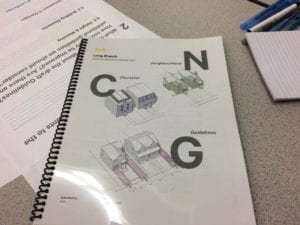Advisory Group for Long Branch Urban Design Guidelines had a productive meeting on Feb. 7, 2017
Update:
A more complete and highly informative overview of the contents of the Feb. 7, 2017 Long Branch Urban Design Guidelines Draft Document is available at the website of Ward 6 Councillor Mark Grimes. We owe thanks to Councillor Grimes for the role that he and his office have played in the initiation and development of the Pilot Project.
Click here to access the overview at the Ward 6 Councillor’s website >
[End]

I took the bus, from Fortieth Street and Lake Shore Blvd. West, in order to get to the meeting. With the freezing rain, I preferred not to drive. Jaan Pill photo
I was very pleased to have the opportunity to attend the Long Branch Community Advisory Group Meeting on Feb. 7, 2017 in connection with the Long Branch Urban Design Guidelines Pilot Project.
In subsequent posts I will upload pages from the draft document, that was distributed at the meeting.
This material will also be available online at the City of Toronto website.
I’ll be posting it at the Preserved Stories website as well. The website is a convenient place – one among many – where we can share information.
Click on the photos to enlarge them; click again to enlarge them further
The meeting took place on the evening of Feb. 7, 2016 at the Ken Cox Community Centre adjacent to Colonel Samuel Smith Park and Humber College Lakeshore Campus.
Date: Tuesday, Feb. 7, 2017
Time: 6:30 p.m. to 8:30 p.m.
Place: Ken Cox Community Centre (28 Colonel Samuel Smith Park Drive)
Room: Cafeteria A (located inside Father Redmond Catholic Secondary School)
Purpose
“This upcoming event,” the organizers informed us in an email, “will be an opportunity for the Long Branch Community Advisory Group to attend a meeting where you can learn more about the ongoing Pilot for the Long Branch Neighbourhoods Guidelines, ask questions and share your comments.”
Highly productive meeting
I found the meeting highly productive. It was set for two hours and it went for two hours.
The first hour was devoted to an overview, by the Guidelines team, of the draft document that has been prepared to date.
In the second half, each of the tables devoted time to a facilitated discussion based on a set of questions, and each table then presented two or three key points, from their discussion, to the group as a whole.
I found the event was well-organized. The discussions that followed were productive and valuable.
I learned a lot, and found that my own views, about a variety of topics, were modified, after I took into account comments from other people at my table. I like it when I learn something new, and change my outlook about things, as a result of focused discussion in which many people share their views.
I look forward to the next steps in development of the Pilot Project.
I will share more information about the meeting tomorrow. It’s now late at night, time to leave it for another day.
But first, I will review the meeting with a focus on the five key elements of a good story, as outlined as previous posts, most recently in one that’s entitled:
I recently made up this formulation, of five elements, after someone asked us, at another meeting that I attended (about another topic), “What makes a good story?”
1. Getting attention
First, you need a hook. There are a lot of lot severances happening in Long Branch. The Committee of Adjustment and the OMB are a cross between Kafka’s “Metamorphosis” and the story of Alice in Wonderland. It’s, like, through the looking glass, That’s your hook. There is a reason for people to have an interest in the story of the Long Branch Urban Design Guidelines Pilot Project.
2. Playing the role
There are several role players here – the Councillor, the Chief Planner, each person from SvN, and the residents of Long Branch.
What was missing, by way of role play, at this meeting, was a microphone and a sound system. You need that, to really get into the role, and it’s my hope that a mic will be available in future. Every event – even a walking event such as a Jane’s Walk – benefits from a mic and a portable amp, or even a stationary amp – as soon as you get more than about 20 people gathered together.
Oh, I forgot, there was a table of developers at the meeting. They have a role to play as well.
3. Collaboration
To take any story on the road, and get some good production values in place to entertain an audience, a large number of talented people usually need to work together with one or two key people coordinating the creative process.
The high quality of collaboration that is evident with the Pilot Project is a source of inspiration for me. What I have seen to date is highly promising.
4. Backstaging
There’s a frontstage – the official reality, and the backstage – what happens behind the scenes.
What’s been happening behind the scenes with the Pilot project? What’s the reason that the project hasn’t already been completed? The earlier announced timelines pointed to an Advisory Group meeting in December 2016. The meeting in question took place in February 2017.
What happened in the backstage, to cause the delay?
I don’t know what the reason may be. Third-hand reports don’t interest me. At this stage, I don’t care what the reason is, that accounts for the delay. What matters the most, at this point, is that we met on Feb. 7, 2017.
The frontstage looks good. Members of the Advisory Group have provided initial input on the draft, at the meeting. They will have the opportunity to offer further reflections in the next week of two, as soon as the draft is online at the City of Toronto website. That’s what matters, at this step: studying the draft and getting input from the members of the Advisory Group to SvN.
5. Open-Endedness
We don’t know where the Pilot Project will lead. We don’t know where this road leads.
It will mean different things to different people. An element of ambiguity will be built into it, as is the case with any great work of art. There’s an element of suspense, an element of anticipation. All this makes for a great story.
[End of storytelling overview]
Exmoor Drive
The next post in a series about the Guidelines is entitled:
Exmoor Drive above TTC Loop is now included in Long Branch Guidelines project



So, how did I change my views, in the second-half-of-meeting discussion at the table I was at? I began with my customary spiel about the distinction between rhetoric and reality. The facilitator pointed out we had a list of questions, and we had the opportunity to offer input on them. I thought that was a good point. I dropped my spiel and spent the rest of the time focusing, along with everybody else at our table, on our detailed responses to the questions.
I also changed my view about opposing all flat-roofed structures, when another resident commented that flat-roofed buildings are fine, on a street of peaked-roof houses, so long as the heights of all the buildings work together. There is so much value in comparing notes, in engaging in focused conversations, about all of the topics associated with planning issues in Long Branch.
I thought, as well, about how the language of urban design, as articulated in the Feb. 7, 2017 Draft Reference Material, is a language that is good to learn. Provided that one knows other languages – I’m thinking, by way of example of the language associated with Erving Goffman’s dramaturgical perspective regarding how situations are defined in the course of ongoing social interactions – it’s great to learn (and to learn to function within the bounds of) such a language of design. The more languages we know, the better.
By way of sharing backstories and contexts related to urban planning issues in the GTA:
A Feb. 8, 2017 CBC article is entitled: “Population of metropolitan area of Toronto outpaced national growth rate: City of Toronto population hit 2.7 million, 2016 census data shows.”
A Feb. 10, 2017 Toronto Star article is entitled: “Don Mills home sells for $1.15 million over asking: The sellers have lived in the three-bedroom home for 50 years.”
A Feb. 10, 2017 CBC article is entitled: Brampton home draws 532 showings and 82 offers: And by the way it sold for more than $200K over its asking price.”
The opening paragraph reads: “The intense competition in the GTA’s record-setting real estate market is starting to baffle even veteran realtors, who are seeing a startling amount of interest in certain properties.”
A Feb. 11, 2017 Toronto Star article is entitled: “Sheltering Toronto’s most vulnerable proves to be a struggle: Toronto’s emergency shelter system struggles to accommodate all those in need in an increasingly unaffordable city.”
I am working my way through a variety of reflections related to the Long Branch Character Defining Conditions. By way of example:
The Long Branch Character Defining Conditions refer (Part “a”) to “Historic Long Branch houses dating back to original ‘villa’ lots.”
The reference brings to mind a May 22, 2008 insidetoronto.com article entitled: “OMB supports Lake Promenade homeowner: Long Branch house on city’s list of heritage properties for demolition, rebuilding.”
A section of Thirty Third St. is was included in the Walking Tour of Long Branch that was a feature of an early stage of the Long Branch Guidelines Pilot Project. Among the houses mentioned in the article is a historic cottage that used to exist at 25 Thirty Third St. The cottage was listed as a heritage property but was torn down anyway. An image of the house remains available online.
I became interested in the history of 25 Thirty Thirds St. when Cairine Johnson, who used to live at the cottage many years ago, contacted me some time back about Long Branch history. Among my ongoing projects is a post or series of posts in which she talks about her memories of Long Branch.
A March 9, 2017 CBC article is entitled: “Good chunk of city ‘overprotected’ from density, says urban planner: OMB blocked half of townhouse development after neighbours protested ‘density creep’”.